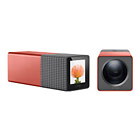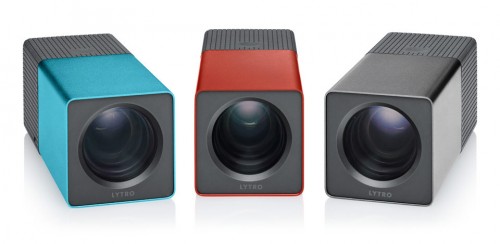 Last week, new camera maker Lytro debuted the first production version of their revolutionary new light field camera. The Lytro camera allows you to take pictures and focus them after the picture is taken – something that has a lot of people very excited – especially major tech news outlets, gadget Web sites and grandmas everywhere. It does this by collecting light rays coming from all directions instead of a limited area like a regular camera. All that light (11 million rays according to the camera specs) is captured with a special micro-lens array sensor and then the data is processed by the camera’s “Light Field Engine” and turned into “Living Images” that can be refocused over and over and even be displayed as 3D photos.
Last week, new camera maker Lytro debuted the first production version of their revolutionary new light field camera. The Lytro camera allows you to take pictures and focus them after the picture is taken – something that has a lot of people very excited – especially major tech news outlets, gadget Web sites and grandmas everywhere. It does this by collecting light rays coming from all directions instead of a limited area like a regular camera. All that light (11 million rays according to the camera specs) is captured with a special micro-lens array sensor and then the data is processed by the camera’s “Light Field Engine” and turned into “Living Images” that can be refocused over and over and even be displayed as 3D photos.
Although I wrote about the Lytro camera in June when it was first announced (original Lytro announcement article), last week’s announcement was the first time a lot of people got wind of it. I got a barrage of questions about the camera followed by some interesting discussions about what makes a good photo and what kind of technology is really important to photography. It’s impossible to say right now how the Lytro camera will change photography but it’s certainly getting a lot of attention – mostly from tech writers and regular folks who are excited because it makes it easier to avoid out-of-focus photos.
In spite of the buzz around the Lytro camera, most experienced photographers see it as more of a gimmick designed to help snapshot photographers avoid mistakes. And that’s a worthy thing to do. However, experienced photographers know how to get a focused photo (most of the time) and decisions about stuff like focus and composition are usually made before a photo is taken. Being able to decide on focus after the fact is not going to make a better photo – it only helps us avoid screwing our photos up. At least, that’s what most experienced photographers I’ve talked to think. However, no one can predict the future. Twenty years ago most of us thought Photoshop was a novelty for computer nerds. Fifteen years ago I didn’t believe digital cameras would ever be a real professional photography tool. More recently, digital camera features like live view, face detection and video all seemed silly to me. But I use all of that stuff now and I couldn’t live without digital cameras, Photoshop or live view. So what do I know about how important the Lytro is? What I know for sure is people are excited about it and that alone means it deserves our attention.
The final design of the first production Lytro camera is curious. I’m not sure what Lytro’s long-term goals are but this first camera looks more like something from Fischer-Price than Nikon. It also comes with built-in memory instead of a memory card slot. The looks and the built-in memory mark it as more of a consumer gadget than a serious photographic tool. That said, the specs are pretty damn good – an 8x optical zoom lens with an f/2 aperture through the zoom range, aluminum body with rubber grip and a 1.5-inch touchscreen LCD display. According their Web site, the Lytro camera will be available in early 2012 to US residents only. Early adopters are going to pay a high price to be the first on their block with a Lytro camera – $399 for the 8 GB model and $499 for the 16 GB model – and you’ll have to have a Mac computer to import and edit your Lytro photos. A Windows version is in development and ultimately they plan for the camera to be available across the globe.
Lytro sample photos >>
Science behind the Lytro camera >>
Sources & Related Content:
Lytro Camera Forum Discussion
More Photography News
Lytro Web Site




If nothing else I am curious about all of this, though me adopting it? I still shoot film for most of my personal work, and digital for pro work. The post-processing work-flow could be a deciding factor for me, in addition to image quality.
I’m curious, if you don’t have to worry about your subject being in focus, what about being blurry do to camera shake, or subject movement? The ergonomics of this camera make it look like it would be kind of hard to hold steady.
Good question, Michael. Camera shake and motion blur of any kind aren’t something the technology addresses. So you still need a good exposure and good technique. I’m not sure what kind of control the camera offers for shutter speed or ISO. And I agree that it looks like it might be hard to hold steady. Maybe this first version won’t be the best for moving subjects. I am trying to get one for review and when I do I will definitely be using it on some moving subjects…
An all-focus camera could have some cool applications and it really does have broad appeal to the general public who are more interested in capturing the moment and not dealing with the technical details of light, composition, and focus.